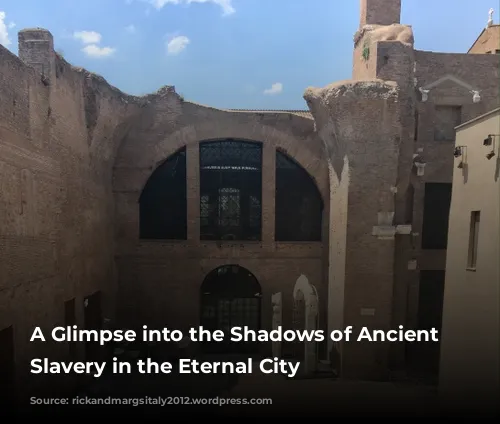Imagine a bustling city, filled with the echoes of history and the whispers of a bygone era. We embarked on a journey through the ancient streets of Rome, guided by the insightful Olivia Ercole and the Canadian Club of Rome. Our focus was a topic often shrouded in darkness: slavery. While the subject might seem uncomfortable, Olivia’s captivating narrative revealed the complex and often brutal reality of slavery in Roman times.
A Different Kind of Slavery
We often associate slavery with the transatlantic slave trade, where people were forcibly transported across vast oceans. But Roman slavery held a unique character. The slaves in Ancient Rome were predominantly Europeans, taken from lands conquered by the Roman Empire. This stark contrast paints a picture of a world far different from the one we often envision when the word “slavery” comes to mind.
Echoes of Slavery in Stone
Our journey began at the Servian Walls, an ancient fortification just outside the Termini station. These walls, dating back to 4 BC, stand as a testament to the forced labor that fueled the construction of Ancient Rome. From the bricks used in buildings to the very fabric of daily life, slaves formed the backbone of Roman society. Their hands toiled in manual labor and highly skilled professions.
The Baths of Diocletian: A Luxurious Legacy Built on Labor
We continued our journey to the Baths of Diocletian, a sprawling complex now housing the National Rome Museum. This magnificent structure, like many others in Rome, was built on the backs of slaves. They fueled the furnaces to heat the waters, serving the wealthy patrons who bathed within its walls. The baths were also a place where men met prostitutes, many of whom were enslaved.
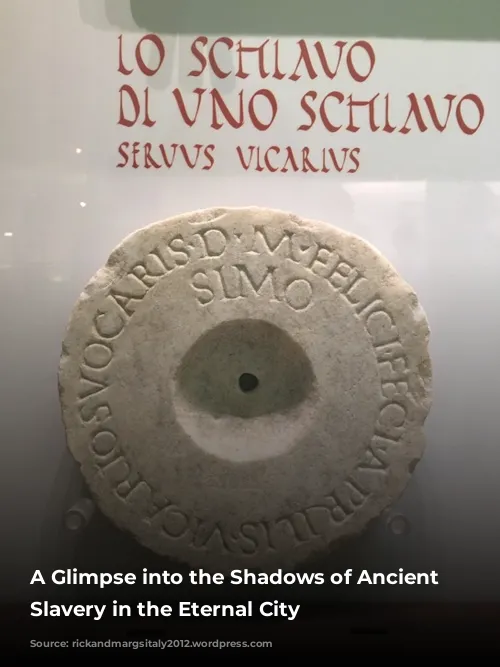
The Cruel Choice: Slavery or Annihilation
The Roman conquest brought a brutal reality to conquered towns and countries. Inhabitants were presented with a horrifying choice: become slaves or face destruction. Roman soldiers marched onward, leaving behind a trail of sorrow and enslavement. The captured populations were swiftly sold to slave traders, who followed in the footsteps of the conquering armies. Triumphant arches, adorned with intricate carvings, depict this grim reality, showcasing the paraded slaves, the vanquished enemies of Rome.
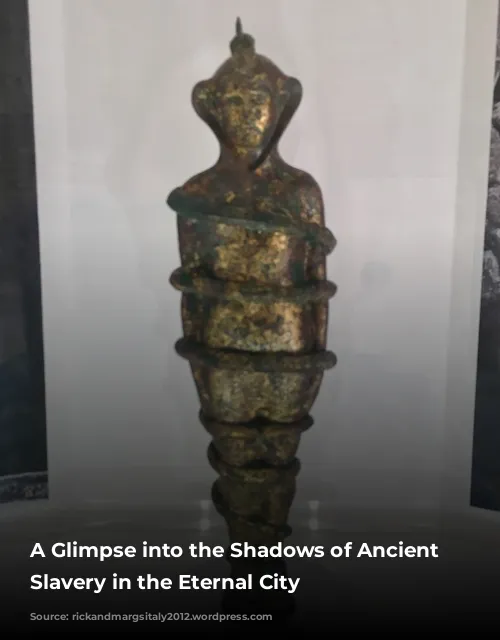
A Life Cut Short: The Harsh Reality of Slavery
Life for the vast majority of slaves was short and brutal. The average lifespan was a mere 20 years, a testament to the grueling conditions they endured. Gladiators, often slaves forced to fight to the death, became a gruesome spectacle for the entertainment of the Roman populace.

A Ray of Hope: Freedom and Social Mobility
While many slaves lived lives of misery, a small number found glimmers of hope. Some highly educated slaves were able to earn their own money, even owning slaves themselves. Through hard work and perseverance, they could purchase their freedom. Freedmen and freewomen could even achieve the status of equites, a social class just below the senators, although they were denied the right to vote. Their children, however, were granted full citizenship.
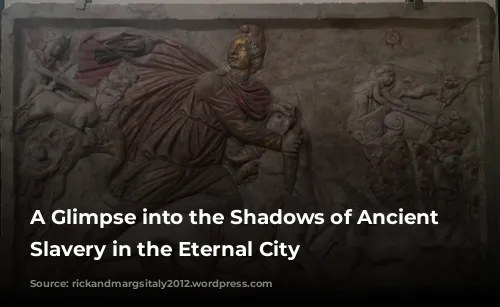
The Legacy of Tiro: A Story of Perseverance
Tiro, the secretary to the renowned orator Cicero, serves as an inspiring example. Freed before his master’s death, Tiro rose to great success, retiring to his own estate and living to the remarkable age of 99. His story offers a glimpse into the potential for upward mobility that some slaves experienced.
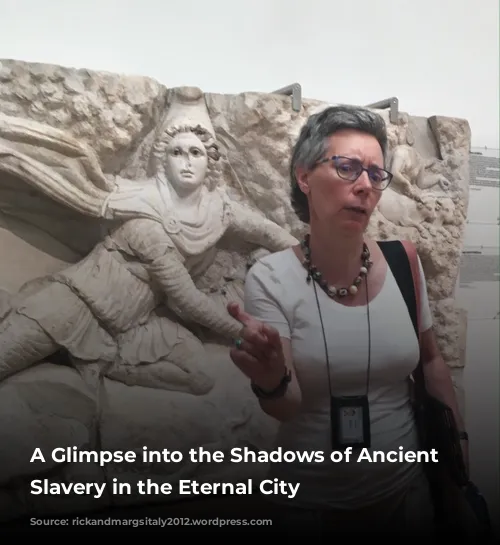
Debt as a Chain: A Different Form of Enslavement
Warfare was not the sole source of slavery in Ancient Rome. Debt played a significant role, ensnaring individuals in a web of servitude. The creditor would place their hand on the debtor’s head, solidifying the agreement. In some cases, sons could be enslaved in their father’s place, though this practice was limited to three times per son.
A Final Farewell: The Afterlife of a Slave
This intricate funerary jar, shaped like a cup with a hole for pouring wine, stands as a poignant reminder of the lives of slaves. It was meant to lubricate their passage to the afterlife, a testament to their enduring presence even after death.
The Shadow of Slavery: A Lasting Influence
By the 1st century BC, slaves comprised a staggering 30 to 40% of Rome’s population. Their presence was woven into the very fabric of the Roman Empire, shaping its economy, society, and culture. Our tour offered a powerful and insightful exploration of the vital role that slaves played in the history of this ancient civilization.
Modern Echoes of Ancient Cruelty: A Continued Struggle
The tour’s impact extended far beyond ancient Rome. Megan K. Williams, an award-winning CBC correspondent based in Rome, brought a contemporary perspective to the discussion of slavery. Her work highlighting the plight of migrants entering Italy resonated deeply with the tour participants. These migrants, driven by desperation, are often forced to pay exorbitant sums to human smugglers, only to be sold into further servitude. The cycle of exploitation continues, as they are forced to work on farms and in factories to pay off their debts. Many women, tragically, are forced into prostitution. This stark reality underscores the disturbing fact that the shadow of slavery, though disguised in modern forms, persists.
A Journey Through Time: Rediscovering Ancient Treasures
The Baths of Diocletian, home to the National Rome Museum, have undergone a magnificent transformation since our last visit. New galleries have been unveiled, showcasing a stunning array of artifacts. Among these, I was particularly captivated by a marble panel depicting Mithras, the ancient god of light and victory. The original paint and gilding remain visible, a testament to the artistic mastery of the past, despite the passage of nearly 2,000 years.
A Pocket of the Past: A Small Idol with Deep Meaning
This tiny idol, standing just 12 inches high, was discovered in a sanctuary on Janiculum Hill. Dating back to the 2nd century AD, it is believed to be associated with the woods and waters, representing a connection to the natural world. This humble artifact serves as a reminder that even in the midst of a vast and powerful empire, ancient Romans sought solace and connection with the world around them.
The journey through the streets of Rome, guided by Olivia’s enlightening narrative, revealed the complexities and brutalities of slavery in the ancient world. While the forms of enslavement may have changed over time, the fundamental issues of exploitation, injustice, and human suffering remain tragically relevant. The echoes of Ancient Rome resonate in the modern world, reminding us that the pursuit of a just and equitable society is an ongoing journey.
